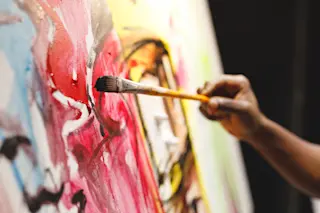Recent research has found that as much as 20 percent of Americans suffer from chronic pain, a condition that is fiendishly difficult to treat. And after a serious injury, Martha Sommers, a physician, made art to cope with her own pain.
“When my pain is most intrusive, it is by drawing that I get the best break. From layering the pastel hues, detailing with pencils, and accentuating highlights with gel pens; my intense focus temporarily overrides the pain messages to my brain,” she writes in a recent blog post. “That this break in the pain cycle creates beauty is a wonderful side effect, that I am now exploring for art’s own sake. And something I so wish for my patients with similar challenges.”
Opioids can relieve pain, but experts find the cost at both the individual and societal level is far too high. In the search for solutions, pain specialists are increasingly turning to a multidisciplinary approach, using psychotherapies and alternative treatments along with pharmaceuticals. However, doctors may have one underused tool in their toolkits: art.
Art as Therapy
While experts still don’t know exactly how art can reduce pain, they recognize art therapy can help in a variety of ways. The most obvious is that it gets your mind off the pain. This isn’t just a matter of distraction, though that helps, too, as Sommers found.
One of the most frustrating features of chronic pain is that it seizes your attention and commandeers your thoughts. Patients feel a lack of control, can spiral and have catastrophic thoughts, which quickly take pain from manageable to maddening. The arts can help restore a sense of control.
Researchers who’ve studied these effects, would understand Sommer’s experience. One study, for example, found that cancer patients experienced less pain after a brief bedside art lesson. Several studies have found that various forms of art — music, dance, drama, even simply looking at a painting — may help patients better cope with pain.
A 2020 report by the National Endowment for the Arts even suggested the arts as a strategy to address the opioid crisis. The report concludes that “arts-based interventions should be considered among potential complementary approaches for managing pain and preventing and treating SUD [substance use disorder].”
Pain Centers and Museums
Your doctor may not give you a prescription for a packet of watercolors or your insurance company may not approve an annual membership to your local art museum — at least not yet. But Ian Koebner, director of Integrative Pain Management at the University of California Davis Medical Center, is working on it.
Koebner and colleagues concluded in a 2018 study that a partnership is feasible and valuable between academic pain centers and museums. Koebner recently collaborated with the Crocker Art Museum in Sacramento, Cali., in a well-received program to use tailored in-person tours (available now via Zoom) to decrease pain and social disconnection for people living with chronic pain.
“An appreciation for the arts’ transformative potential is not new. However, curating arts experiences for and with individuals living with persistent pain, along with the rigorous, interdisciplinary and inclusive evaluation of these experiences is novel,” says Koebner.
Earlier this year, Koebner organized a seminar that included scientists, health care and museum professionals, as well as individuals living with chronic pain. The meeting’s goal was to encourage an interdisciplinary network of professionals to develop methods of treating pain with the arts.
“The arts,” says Koebner, “may be uniquely positioned to help individuals imagine what is possible for themselves and society, to inspire people to live with resilience and creativity.”
The arts could address pain for the patient, but it could go beyond that as well. There is also a need for society to develop compassion for those living with pain. Artists such as Eugenie Lee and Justus Harris use art to explore and express what it’s like to live with chronic illness and chronic pain, thus bringing pain from the individual experience to a collective one.
“The arts may be a valuable mechanism for helping society, health care professionals, and the public alike to be more educated and compassionate about the lived experience of pain,” says Koebner.
Addressing the opioid epidemic and helping people who live with pain will require a variety of approaches and a community effort. We could start in the museum.















